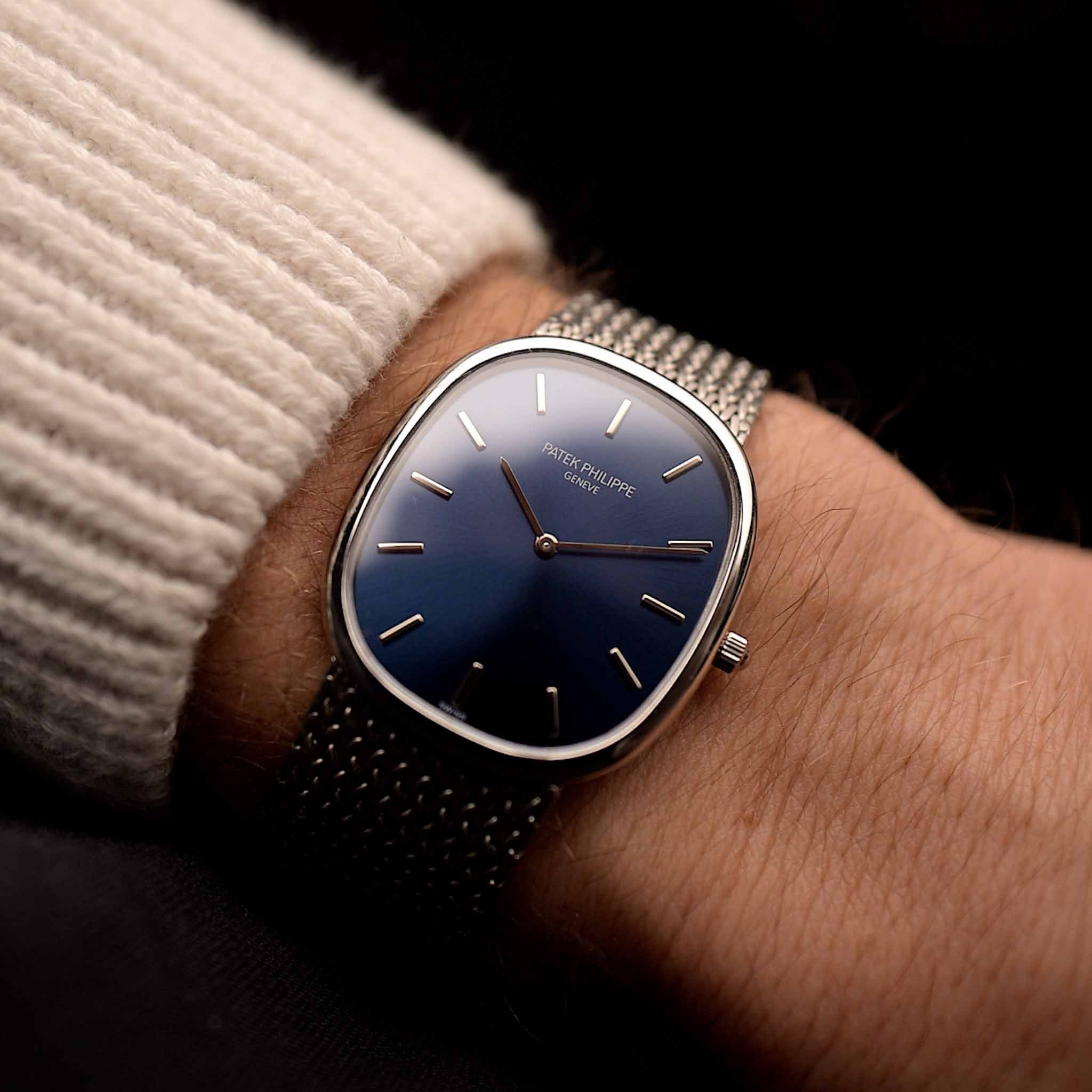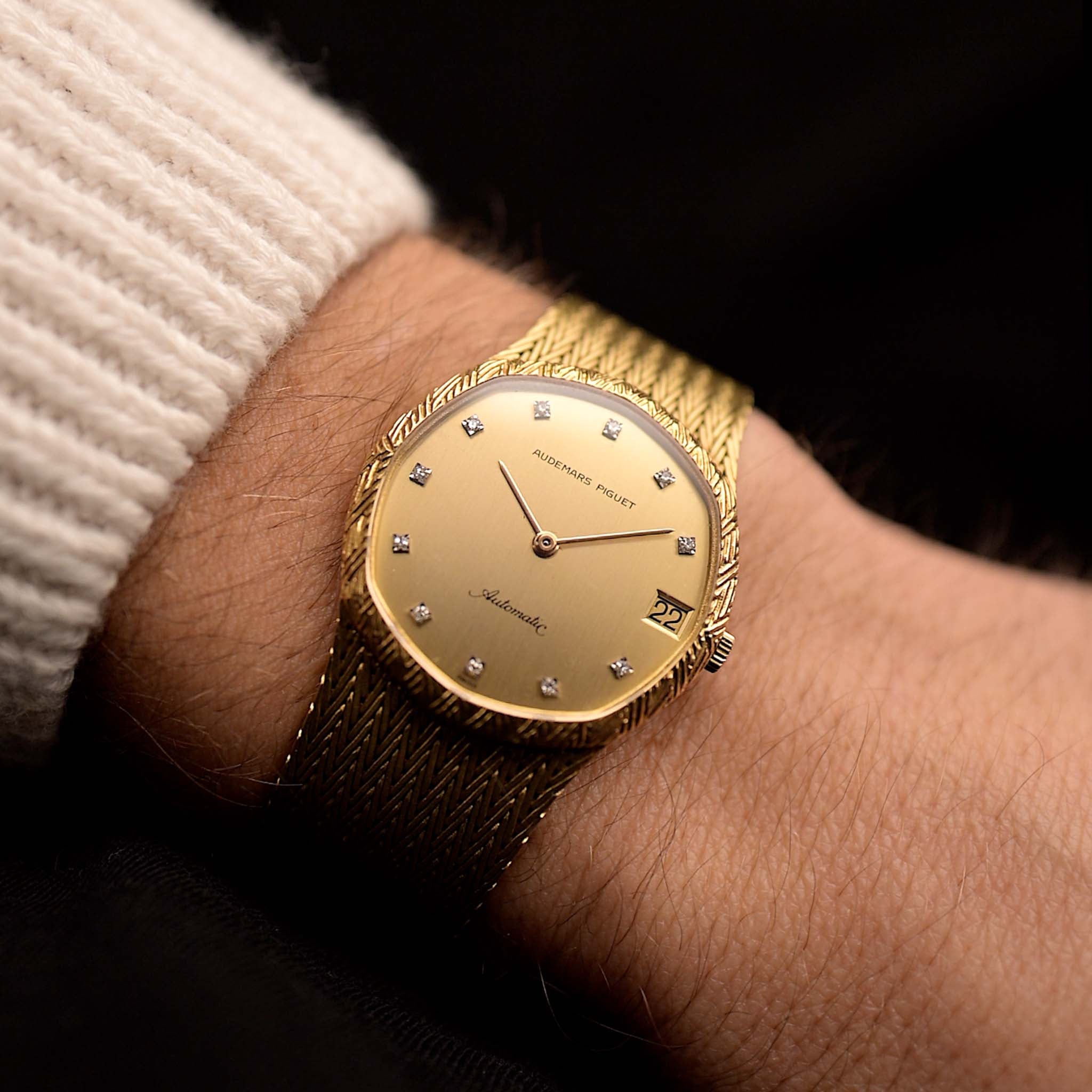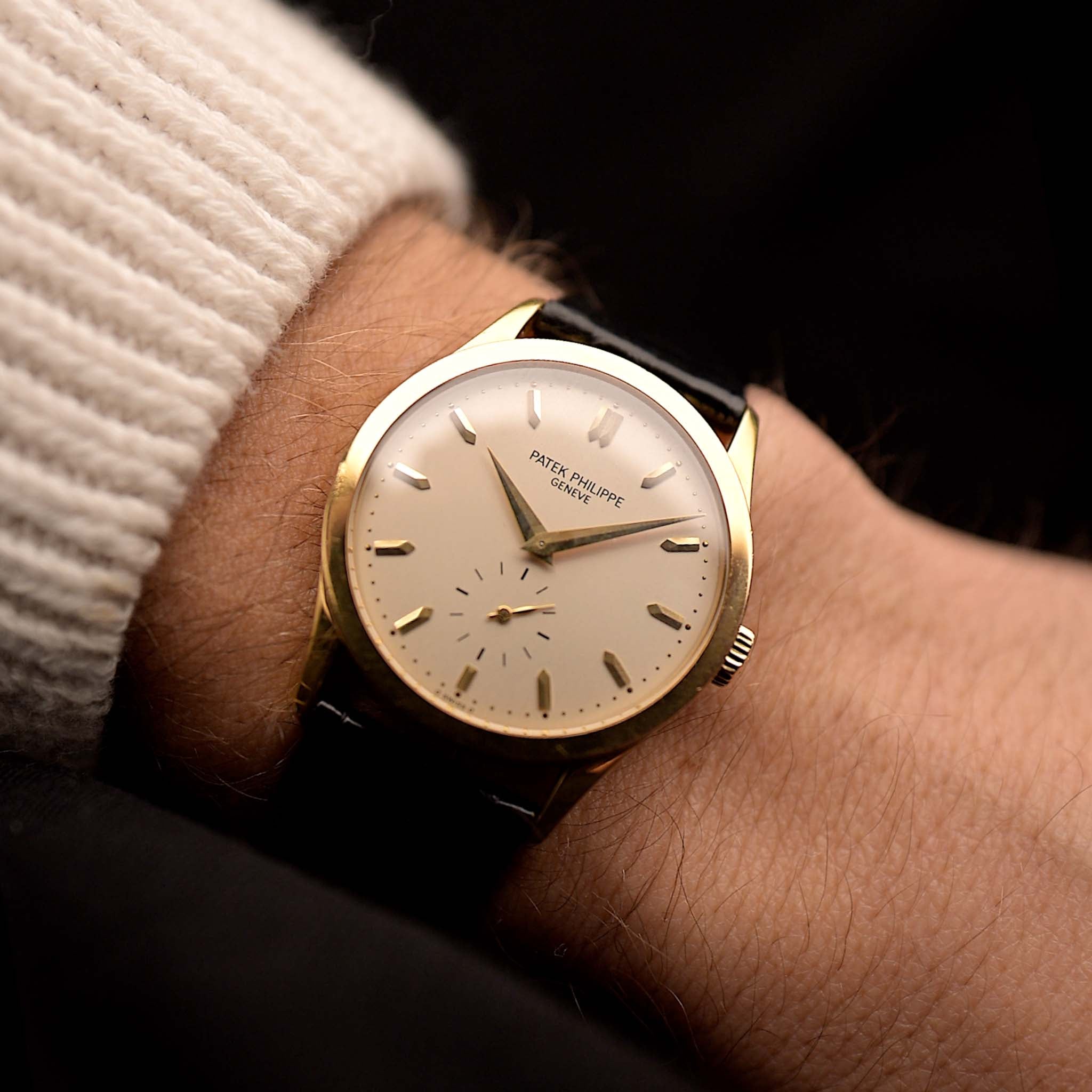The late 1970s gold prices shook the Swiss watch industry and led to important changes. Coming on the heels of the new Quartz technology the gold price surge ignited a paradigm shift in watch design and the marketing and perception of luxury. The gold price surged from 35$ in 1970 to over 800$ just 10 years later. Another crisis of colossal extent.
January 31, 2024
The Gold Crisis - Re-evaluating 1970s & 80s Watch Design

Marcus Siems @siemswatches
Collector, Author, Data Analyst
The Swiss watch industry was shook hard in the 1970s and 80s... Many, if not most employees were let go, manufacturers had to close down and several Century old household names had to leave the picture. This is what we today call the Quartz Crisis - the rise of cheaper produced high-accuracy Quartz movements was threatening the very core of traditional mechanical watchmaking[1-4].
However, technological breakthroughs in movement technology were likely not the only factor* involved in this downfall and the changes of the Swiss watch industry[4-6]. Particularly a recent blog post from Manuel @PlusUltra_Ch made me aware of another important piece of the puzzle: The Gold Price.
 Figure 1. Historic evolution of the gold price (per ounce) between 1968 and 2000. Data Courtesy of TradingEconomics.
Figure 1. Historic evolution of the gold price (per ounce) between 1968 and 2000. Data Courtesy of TradingEconomics.
Up until 1970 the US Federal Reserve capped the gold price at $35 per ounce[5]. This means that only in 1970 market fluctuations and speculation on the gold value were introduced into its pricing. This led to an enormous spike in its valuation... up to $667 (>$840 peak trading days). That is over a 20-fold price explosion in only 10 years!
1) Translation to Retail Prices
Let's do some simple math what this increase would mean for the final watch price... For example a classic Rolex Day-Date in 18k yellow gold on a President bracelet weighs in at around 120-130g. That's roughly 2.5 ounces (75g) of pure gold[6]. In 1970 this adds to a material value of ~$87... in 1980 this increases to ~$1,667. Over the same period the retail price of an 1803 Day-Date increased from $1,850 (1973) to $7,950 (1980)[7]. So that's about an 8x increase for gold (1973-80) versus "only" a 4x increase in retail price.
 A sight that is becoming more and more paired with Haute Horlogerie in the 1970s - A full 18k gold bracelet watch. Photo 1970s Patek Philippe 3588, from the Goldammer Archives.
A sight that is becoming more and more paired with Haute Horlogerie in the 1970s - A full 18k gold bracelet watch. Photo 1970s Patek Philippe 3588, from the Goldammer Archives.
In other words, the gold price increase has been slowly chipping away the margin on these pieces. And a President Day-Date Rolex has been one of the more pricier pieces with respect to its gold content. Other pieces in 1970 were sold at "only" 3-4x their respective gold value[5]. Here, the margin would basically be gone by the mid-70s.
We can clearly see how Rolex had to try to keep up with these developments and how this contrasted the pricing of their steel models. Around 1980 - when the gold price would peak - Rolex strongly increased retail prices for their gold - and even two-tone - watches to about 4x the level of the early 1970s. Their respective steel models on the other hand reached only around 2x that level in 1980.
 Figure 2. Retail Prices of Key Rolex Models relative to their 1973 level[7]. You can see the most dramatic increase for gold watches between the 1978 and 1980 retail price adjustments. Displayed references are Rolex Day-Date (1803X+ YG), Submariner 1680 in steel and 18k YG, and the Datejust 1601X in steel and bicolor. Data Courtesy of Minus4Plus6.
Figure 2. Retail Prices of Key Rolex Models relative to their 1973 level[7]. You can see the most dramatic increase for gold watches between the 1978 and 1980 retail price adjustments. Displayed references are Rolex Day-Date (1803X+ YG), Submariner 1680 in steel and 18k YG, and the Datejust 1601X in steel and bicolor. Data Courtesy of Minus4Plus6.
This drastic increase becomes even more evident when we directly compare steel models versus their respective golden equivalents. A Submariner ref. 1680 in 18k gold and bracelet would cost you about 5x as much as a steel ref. 1680 in 1973. Seven years later the same references are about 9.5x apart in retail price.
 Figure 3. Relative Price Difference between Key Rolex Models - Submariner Date (top) and Datejust (bottom) - in steel vs. gold/bicolor. Data Courtesy of Minus4Plus6.
Figure 3. Relative Price Difference between Key Rolex Models - Submariner Date (top) and Datejust (bottom) - in steel vs. gold/bicolor. Data Courtesy of Minus4Plus6.
A similar picture emerges even for bicolored pieces like the Datejust lineup. In 1973 a two-tone Datejust 1601X would cost you about 1.5x as much as a classic steel example. In 1980 this ratio increases to over 2x. And we can see that these drastic gold premiums would stay pretty high up until the 1990s.
2) Reorientation
Imagine you're a watch brands executive in the 1970s. Prices for raw materials like gold skyrocket and you have no idea where it'll end... What do you do? Giving the cost increase of manufacturing 1-to-1 to the customers without improving on the product itself? Arguably tough to do when your entire industry is already in a battle with a cheaper product (the Quartz watch). So you put your eyes on alternatives.
 A 1980s Cartier Santos Carree in steel and gold... An elegant testament to the rocky times it was born into. Photo Goldammer Archives.
A 1980s Cartier Santos Carree in steel and gold... An elegant testament to the rocky times it was born into. Photo Goldammer Archives.
One of the better examples how to maneuver through this stormy golden sea has probably been Cartier. La Maison historically only produced watches in gold (or rarely platinum), only precious metal, nothing less. However, they displayed tremendous foresight during the 1970s when they introduced the 'Le Must' lineup and later their Santos Carree watch models.
The le Must de Cartier line was launched in 1973 for various accessories and later in 1977 with the Tank Must[8-9]. The novelty on these pieces was that they used gold-plated** sterling silver cases to save up on material costs and enable a broader audience the pleasure of the Cartier style. Design meets availability.
 The two main paths Cartier took to adapt to increasing gold prices and to bring affordable luxury to the portfolio. And both actually turned out to become success stories. Photos Goldammer Archives.
The two main paths Cartier took to adapt to increasing gold prices and to bring affordable luxury to the portfolio. And both actually turned out to become success stories. Photos Goldammer Archives.
The Cartier Santos Carree on the other hand was a modern new-interpretation of basically the very first Cartier wristwatch - the Santos Dumont[10]. Going down a slightly different path than with the Tank Must, Cartier introduced the Santos Carree in 1978 as a "luxury sport watch". Hereby Cartier used a steel frame with 18k golden accents - or in other words a two-tone watch.
And speaking of the luxury sports genre... this was basically the angle most high-end watch manufacturers used to adapt to the changing environment. And why not? At the beginning of the 1970s the space-age era was in full swing. The lust for steel and utility driven watches was high and there's been the chance to change the luxury narrative in a very similar direction.
 Two quite different approaches on how to sway the perception of luxury... On the one hand, the bold Audemars Piguet (left) embracing steel as simply being better than gold (translated "The Royal Oak makes gold green with envy"). On the other hand, IWC (right) strongly putting the sturdy characteristics into the foreground, redefining luxury through functionality (translated "[...] numbered and produced in limited series [...] the robust, elegant and sporty model of exclusivity [...]"). Photos Courtesy of HIFI Archiv.
Two quite different approaches on how to sway the perception of luxury... On the one hand, the bold Audemars Piguet (left) embracing steel as simply being better than gold (translated "The Royal Oak makes gold green with envy"). On the other hand, IWC (right) strongly putting the sturdy characteristics into the foreground, redefining luxury through functionality (translated "[...] numbered and produced in limited series [...] the robust, elegant and sporty model of exclusivity [...]"). Photos Courtesy of HIFI Archiv.
The marketing machinery started to sway the public perception away from gold as the "gold-standard" for luxury. Watches were no longer sold based on their material but rather how this material has been processed. The true luxury seemed to have been a watch that fits every lifestyle.
3) Paradigm Shift in Watchmaking and Our Perception of the 1970s & 80s
What I want everyone to take home from all of this is how a resource crisis can affect this entire industry. Not every watch is made from 18k solid gold but when you lose this material as basis for the mid-range luxury watches, entire designs, collections and brands will start to break apart. Moreover, we now know that a number of gold watches (and their bracelets) produced before the 1980s were melted down for gold[6]. It's probably one of the worst consequences for an artisanal craft like watchmaking when the value of the product is reduced to the material alone.
 Imagine Artdeco watch design without the sunny luster of yellow gold... It wouldn't have been the same. Photo Goldammer Archives.
Imagine Artdeco watch design without the sunny luster of yellow gold... It wouldn't have been the same. Photo Goldammer Archives.
These developments did have a manifold of consequences for the design landscape of Swiss watchmaking. Restraining the role of gold affected how watch manufacturers envisioned new models and collections. The high price led to an impressive paradigm shift in the perception - or rather the sales strategies - of luxury items towards steel. Craftsmanship, finishing and particularly design and functionality were put atop pure bling. Well, at least that is part of the story:
 Figure 4. Relative Distribution of Bicolored and Gold-Plated watches between 1960-2000. Data Courtesy of Chrono24.
Figure 4. Relative Distribution of Bicolored and Gold-Plated watches between 1960-2000. Data Courtesy of Chrono24.
The other direction was the "Cartier way": Using smart tricks to make luxury and design-driven watches look as good and shiny as before with actually less gold***. Gold-plating and bi-colored pieces see a clear surge during the 1980s with over 20% of the pieces coming in one of the two options - an alltime high. You know, people still wanted gold(-color)... just not paying full price for it.
All in all, during the late 1970s the manufacturers found themselves in an extremely volatile market for this vital resource for luxury items. Basically, long term strategies based on gold were impossible. Brands had to adapt to keep their profile in the luxury segment. Putting all these dots together; to me this means that as much as Quartz technology challenged traditional Swiss watchmaking on a technological level, the gold price did the same for design. And for the result... I guess I might put it as follows: "80s watchmaking is like 90s music"... and I leave it here.
* Maybe not even the most important factor shaping the industry in the long run[4]?
** Here, plating with the "Vermeil" method[9]
*** Manuel @PlusUltra_Ch also pointed out that several manufacturers started to make watches smaller and lighter additionally saving up on gold. But we'll have to wait for his Part III on the matter for more evidence on this aspect[6].
+ Rolex upgraded the Day-Date/Datejust line in the late 70s with a new movement, crystal and switched from 4-digit to 5-digit references.
References
[1] Four Revolutions Part I: A Concise History of the Quartz Revolution; Joe Thompson, Hodinkee; [Link]
[2] The Quartz Crisis; Caitlyn Bazemore, Crown And Caliber; [Link]
[3] The Quartz Crisis wasn't solely to blame to blame for the industry downfall; Fergus Nash, Time & Tide; [Link]
[4] Debunking the Quartz Crisis; Stephen Foskett, Europastar; [Link]
[5] Gold & Watches Part 1 - #GoldPlusWatches; Manuel Knospe, PlusUltraCh; [Link]
[6] Gold & Watches Part 2; Manuel Knospe, PlusUltraCh; [Link]
[7] Rolex Price Evolution; Minus4Plus6; [Link]
[8] History Of The Cartier Tank Must; Liz Stinson, Hodinkee; [Link]
[9] A Guided History Lesson of the Cartier Tank; Nick Ainge-Roy & Sam MacKinnon, Wynn And Thayne; [Link]
[10] Cartier Santos - A Brief History; Tony Traina, Rescapement; [Link]
All rights on text and graphics reserved to the Author.



























Leave a comment